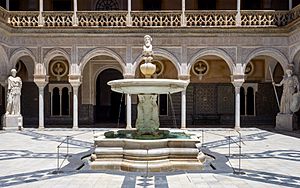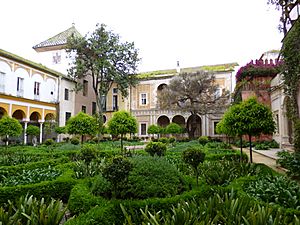Casa de Pilatos facts for kids
La Casa de Pilatos (which means Pilate's House) is a beautiful old palace in Seville, Spain. It's in the region of Andalusia. Today, it's still the home of the Dukes of Medinaceli.
This palace is special because it mixes two amazing styles: Italian Renaissance and Mudéjar. Mudéjar is a Spanish art style that blends Christian and Islamic designs. Many people think it's the perfect example of an Andalusian palace.
The Casa de Pilatos is also famous for its huge collection of azulejos. These are beautiful Spanish glazed tiles. It has about 150 different designs from the 1530s! These tiles were made by two brothers, Diego and Juan Pulido. It's one of the biggest azulejo collections anywhere.
History of the Palace
Building this amazing palace started in 1483. It was begun by Pedro Enríquez de Quiñones and his wife, Catalina de Rivera. Pedro was a very important leader in Andalucía.
Their son, Fadrique Enríquez de Rivera, finished the palace. He was the first Marquis of Tarifa. In 1519, he went on a trip to Jerusalem. This trip is why the palace got its unique name, "Pilate's House."
When Don Fadrique came back from his trip in 1520, he started a special tradition. In 1521, he began the "Holy Way of the Cross" in Seville. This path started at a chapel in his palace. It ended at a cross outside the city walls.
The distance of this path was the same as the distance from Pontius Pilate's house to Calvary in Jerusalem. Because of this connection, the palace became known as the Casa de Pilatos. Over time, people even mistakenly thought the palace was a copy of Pilate's house! That's why some rooms have names like "Hall of the Praetorian."
The Spanish government declared the palace a National Monument in 1931. The first time the name Casa de Pilatos was officially written down was in 1754.
In the 1500s, an architect named Benvenuto Tortello helped rebuild parts of the palace. He made sure to keep the older Mudéjar rooms just as they were.
Exploring the Palace
You enter the palace through a grand marble gate. It was designed in 1529 by Antonio Maria Aprile. Above the gate, there's a Gothic crest.
The gate leads into a classic Andalusian courtyard. In the middle, there's a fountain. Around the courtyard, you'll see 24 busts, which are sculptures of heads and shoulders. These busts show Spanish kings, Roman emperors, and other important people. They were found in the ruins of an old Roman city called Italica.
From the courtyard, you can walk into two beautiful gardens. These gardens have special decorations called plateresque.
To go upstairs, you take a staircase decorated with many azulejo tiles. The ceiling above the stairs is made in a Mudéjar honeycomb style. It was created by Cristobal Sanchez.
The rooms on the top floor have many important paintings. These paintings are from the 1500s to the 1800s. One famous painting is the Pietà by Sebastiano del Piombo.
In one room, the ceiling has amazing frescoes painted by Francisco Pacheco. They show the story of Hercules. In another room, there's a small painting of a bullfight by Francisco Goya. You can also see a painting of Mary Magdalene from the 1500s. The library has three artworks by Luca Giordano.
Like many old palaces, the Casa de Pilatos has its own chapel. It mixes Gothic and Mudéjar styles. The palace is open to visitors all year round.
Filming Location
The Casa de Pilatos has been used as a setting for several movies. Some big Hollywood films have been shot here:
- Lawrence of Arabia in 1962
- 1492: Conquest of Paradise in 1992
- Kingdom of Heaven in 2005
- Knight and Day in 2009, starring Tom Cruise and Cameron Diaz
See also
 In Spanish: Casa de Pilatos (Sevilla) para niños
In Spanish: Casa de Pilatos (Sevilla) para niños




